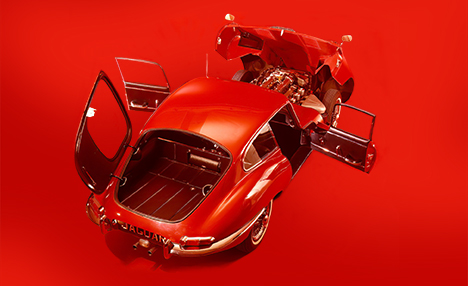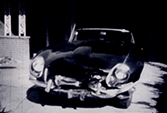Of all the specialist British car makers of the 1950s, the TVR Company of Blackpool, Lancashire, had the most intimate relationship with America. In fact, the company’s early survival was due primarily to one Ray Saidel, who was the proprietor of the Merrimack Street Garage in Manchester, New Hampshire.
Ray’s father opened the garage in the 1920s and went on to become a dealer for several American makes including Hupmobile and Oldsmobile. Ray took over after his father’s death, and by 1957 he’d added Triumph, MG, Mercedes-Benz, and Alfa Romeo into the bargain!
Ray was obviously on enthusiast, and started racing in the early ’50s. Then came an Allard J2X in 1953, and with it, a New England Region SCCA Modified Championship. Saidel was always on the lookout for the latest in racing cars and was intrigued by an advertisement in the August 1955 issue of Autosport magazine.
He took note of the TVR Engineering Company, who claimed they were building a chassis which was suitable for engines up to two liters but weighed only 64 pounds! An inquiry confirmed availability of the chassis, which was being built to accommodate the new all-alloy Coventry Climax overhead cam 1098a racing engine. He needed no further information and placed an order on the spot. Lucky thing, too, because TVR had invested most of their assets on the magazine ad, and their ability to pay the welder came in the form of Saidel’s check!
TVR had been building chassis for several years with a variety of engines. Bodies were either custom-built alloy shapes or any one of several fiberglass offerings of the time. Clothing the chassis preserved no problems for Saidel, because he employed a panel beater who had already bodied several earlier race cars in the Merrimack Garage stable. These cars carried JOMAR badges after Saidel’s daughter Joanna (JO) and his son Marc (MAR). Oddly enough, the TVR marque name originated from three letters of its founder, Trevor Wilkinson’s, first name!
Saidel had good reason to be excited about the TVR chassis. It was a very basic box tube affair with structures at both ends to accept the VW-based torsion bur independent suspension. Despite its minimalist appearance, the chassis was commendably rigid, and the suspension, never mind its humble origins, yielded very good handling, Of course, a weight (minus fluids and body) of about a thousand pounds helped matters considerably. The brakes, incidentally, were large Alfins (finned aluminum drums with cast iron liners).
Saidel was delighted with the first chassis he received and placed an order for two more. His men shaped a simple all roadster body, added a roll bar, and headed for Thompson Raceway for testing. Alas, a few laps at speed resulted in a broken kingpin and several tube failures at the brazed joints.
A panic communique resulted in redesigned steering joints and new weld specifications. The second and third chassis were built to include the modifications and Saidel had these clothed in similar fashion to number one. Eventually, all three were sold off to other racers, with number two going to Bob Columbosian of Columbo’s Yoghurt fame. Although TVR supplied the chassis, the cars were badged as Jomars.
However, by then, Ray Saidel was at once pleased and disappointed with TVR. He liked their innovation and the power-to-weight ratio of their chassis, but he was dismayed at their lack of development and their sometimes substandard building methods. He fired off a list of suggested improvements which, to his satisfaction, were incorporated in the next generation of TVRs. Interestingly enough, these new cars were bodied in fiberglass, to a TVR design, and fitted with stage two Climax engines, center-lockwire wheels, and bigger brakes. To ensure orders, TVR appointed Saidel (Merrimack Garage) sole distributors of their cars in the United States. Part of the deal was that the cars would be sold as Jomars despite the fact they would be delivered completely fitted and trimmed out in England.
Two fiberglass roadsters were built at the TVR works. One was badged as a TVR and remained in England, and the other was sent to Merrimack Garage as a Jomar. This car is owned by Jim Duncan of Cumbria, California. Duncan’s car is chassis number 7C105 and was raced extensively in New England after it was delivered in August of 1957.
Duncan’s Jomar has the Stage 2 Climax, big Alfln drums, and a revised suspension suggested by Saidel. It also features a head fairing and rigid tonneau over the passenger area. Duncan has not restored his Jomar and it bears the wrinkles of a hard-used sports racing car. A recent run up Highway 1 from Cambria to the Laguna Seed Raceway for the Monterey Histories proved the car was still capable of very rapid motoring indeed.
Three other fiberglass cars were delivered to Saidel after Duncan’s roadster, and these were identical except that notchback canopies were added to transform the cars into coupes. A name change (in England) to Grantura accompanied these impossibly ugly attempts at a Gran Turismo automobile. Both were right-hand drive, cramped, and, sadly, very poorly built. Saidel complained, but TVR responded that the new direction the company was headed in was a line of road-going GT cars. All out racers were no longer to be their primary focus. Saidel sent a letter back suggesting better build quality and perhaps fastback in place of the homely notchbacks.
Again, TVR responded to Saidel’s suggestions and they designed a fastback which would establish the general TVR contours for the next 20 years. In fact, elements of the roadster cum fastback still exist in current offerings from TVR. Saidel didn’t seem all that upset about the company’s new direction, perhaps because the Jomar/TVR sports racers were being caught by the new generation of British race cars from Lotus and Cooper. In fact, he welcomed seeing the new fastback coupe, which shared the same lower body shape as the earlier roadsters.
The second fastback was delivered in time for the New York Auto Show in April 1958. The car was much improved, both in styling and execution, and Saidel was pleased at what he saw, but was even more pleased by the response from the public and other sports car dealers. About half a dozen of them signed up to sell Jomars and committed themselves to orders totaling about 100 cars.
Unfortunately, back in the U.K., TVR was undergoing internal straggles and only a trickle of cars were delivered, and most were TVR Granturas for domestic use. The few Jomars that appeared were poorly constructed and still right-hand drive, despite assurances that left-hand steering was coming. Saidel’s enthusiasm had begun to wane—that is, at least for his business side, because his interest in racing the Jomar was as strong as ever, and during the winter of 1958/59 he had his mechanics install and develop a supercharger for his climax-powered roadster.
The big news in England was that Layton Sports Cars Ltd. had taken over TVR and infused a significant sum of cash to improve the product and hasten production. Saidel was invited to travel to England and was offered a position in exchange for a 20-year commitment to distribute Jomar/TVR east of the Mississippi. Saidel also agreed to accept 25 cars per year.
Alas, when the paperwork arrived from England, it stated that Saidel would accept 50 cars each year! His response was short and sweet: “In the future, the trademark Jomar will apply only on cars manufactured by Saidel Sports Racing Cars, a division of Merrimack Garage.” Saidel simply told TVR that he was no longer interested. It seems Layton Sports Cars had not done their homework and as a result they were unaware that Saidel was by then a dealer for Austin-Healey, MG, Triumph, Jaguar, Morgan, and Sunbeam! As such, they certainly didn’t need a car maker of TVRs on again-off again nature!
Despite overtures to return to the fold, Saidel was steadfast. TVR had lost their American competition department, their American development department, and their number one proponent. As British luck would have it, TVR was by then healthy enough to proceed on their own, but it would be years before their cars were again sold in America and they would never again be cAlled Jomars.
Ray Saidel quit racing in 1963 but kept several cars in the Merrimack Street Garage. It was lucky he did, because today Ray and his two sons race Jomars in historic events on the east coast. Of 24 cars (including two chassis which pre-dated TVR), the existence of 13 is known. All in all, a pretty select group of enthusiasts, these owners of Jomars, the American TVR.







'Jomar, the American TVR' has no comments
Be the first to comment this post!